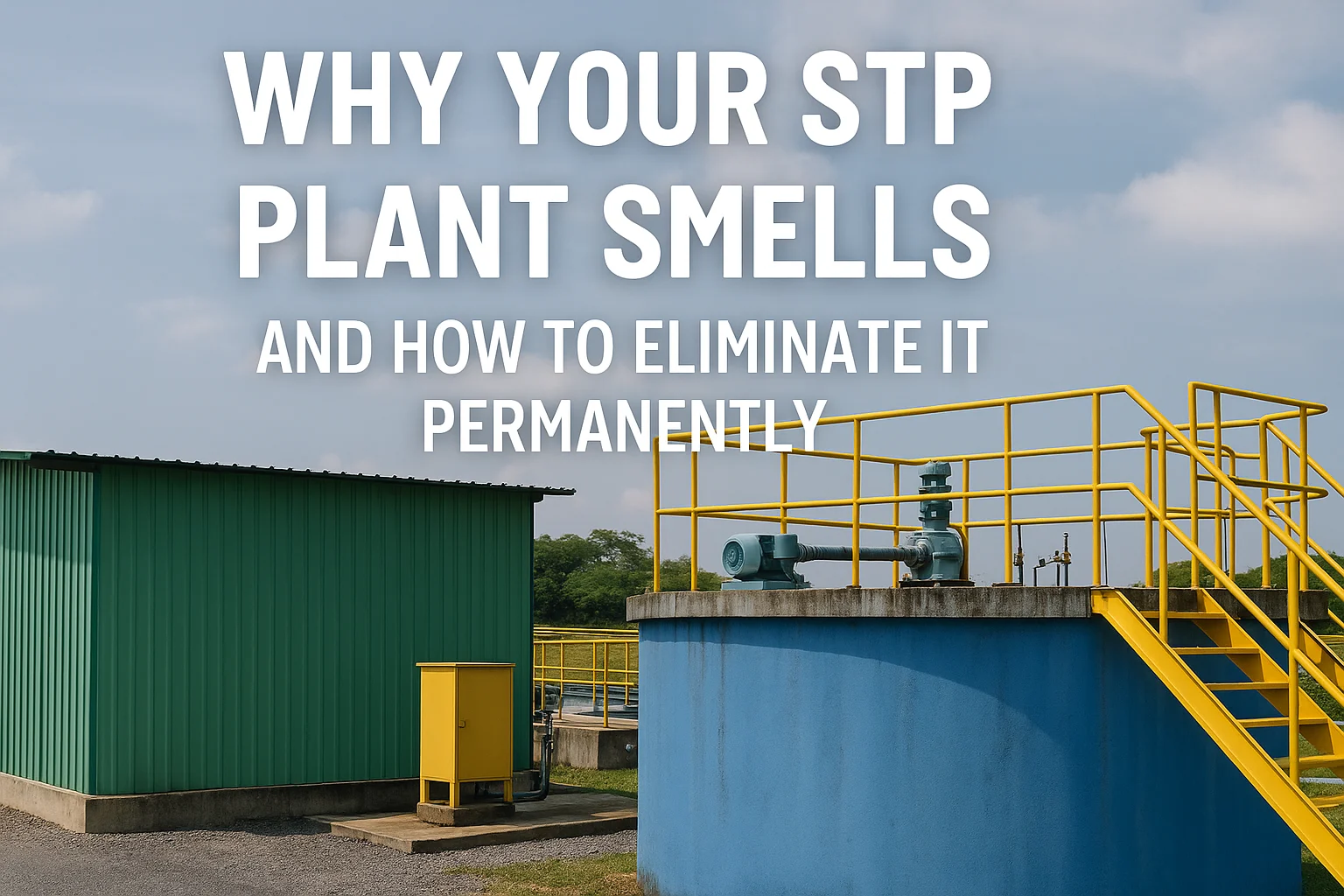Why Sewage Treatment Plants Smell and How to Fix Them?
If your Sewage Treatment Plant (STP) is smelly, you’re not alone, and it’s more than a nuisance. STP plant smells are a clear sign that something’s amiss behind the scenes. Whether you have a domestic STP, hospital STP, or industrial sewage plant, a smell problem is an open red flag that your system is not performing efficiently.
Nuisance odour from STP facilities is a frequent concern for facility managers, apartment dwellers, and industrial plant operators. These odors usually indicate more serious issues of inadequate aeration, excessive sludge growth, or biological imbalance. If left unaddressed, these odors can become full-blown health threats and regulatory violations. Here at HECS, India’s most experienced STP manufacturer, we’ve assisted hundreds of customers in eliminating annoying STP odors—and in this manual, we’ll reveal to you specifically why your STP stinks and also how you can stop it for good with genuine solutions supported by more than 20 years of field practice. From contemporary Packaged STP layouts to intelligent odor control systems, we will discuss what really works to ensure your plant continues running clean and smelling great.
Why Does an STP Plant Smell Bad?
Smells from your STP usually mean that some part of the treatment process isn’t working as it should. Here’s what could be going wrong:
1. Low Aeration—The #1 Cause of Rotten Egg Smell
When oxygen levels in your STP’s aeration tank drop, the environment turns anaerobic, causing bacteria to release hydrogen sulfide (H₂S)—the gas responsible for that notorious rotten egg odor.
What You Can Do:
- Upgrade to energy-efficient blowers and fine-bubble diffusers
- Perform routine blower and diffuser maintenance
- Switch to AI-based smart aeration systems that auto-adjust oxygen levels.
2. Sludge Buildup – Silent Source of Toxic Gases
Excess sludge Sitting too long can produce gases like methane, ammonia, and sulfur compounds, all of which worsen STP odor.
Fix It By:
- Regularly desludging the aeration and settling tanks
- Using automated sludge level monitors
- Installing HECS’s advanced sludge handling units designed for odor-free operation
3. STP Overload – When Your Plant Can’t Keep Up
Running your plant beyond its designed capacity or with unstable BOD, COD, MLSS, or pH levels stresses the biological system and leads to incomplete treatment—and yes, smells.
Action Plan:
- Monitor and limit hydraulic and organic loading
- Use online sensors for real-time water quality tracking.
- Fine-tune chemical dosing and aeration using inflow quality data
4. Blocked Equipment or Damaged Components
A clogged pipe or broken pump can cause stagnant water, which quickly turns foul-smelling.
Prevention Tips:
- Follow a monthly maintenance routine
- Replace faulty parts immediately.
- Choose HECS STPs with smart sensors and automated alerts.
5. Poor Pre-Treatment—FOG is a Major Culprit
Grease, oil, and kitchen waste should never enter the STP untreated. They degrade slowly and release volatile organic compounds (VOCs) and foul gases.
Best Practices:
- Install grease traps at the source
- Use FOG (Fats, Oils, Grease) separators at the inlet section.
- Educate housekeeping and kitchen teams on waste separation.
6. Lack of Proper Ventilation
STPs in basements or closed rooms often trap gases like methane and H₂S, amplifying the smell.
Odor Control Tips:
- Use vent pipes, exhaust blowers, or bio-filters
- Add activated carbon scrubbers for gas neutralisation.
Ensure your STP layout supports natural airflow.
How to Eliminate STP Smells Permanently – Pro Tips from HECS
Eliminating odor is about treating the cause, not just the symptom. Here’s a proven action plan:
Improve Aeration System
- Install fine-bubble diffusers
- Upgrade to smart aeration blowers.
- Automate aeration using AI-powered systems
Control Sludge Accumulation
- Set up a desludging calendar based on MLSS data.
- Use dewatering systems or sludge drying beds.
- Monitor sludge age and prevent anaerobic pockets.
Balance Your Biological Process
- Track pH, BOD, COD, and MLSS using CPCB-approved sensors
- Avoid shock loads by using equalisation tanks.
- Monitor inflow regularly and adjust process parameters.
Ensure Preventive Maintenance
- Inspect blowers, pumps, diffusers, and pipes monthly.y
- Keep spare parts ready to avoid breakdown delays.
- Invest in predictive maintenance tools for critical equipment.
Pre-Treat Wastewater the Right Way
- Install bar screens, grease traps, and oil interceptors.
- Reduce organic and inorganic overload before it enters biological treatment.
- Maintain equalisation tanks to avoid process imbalance.s
Use Ventilation + Odor Scrubbing Add-ons.
- Fit vent pipes with odor traps
- Add carbon filters, UV systems, or bio scrubbers.
- Customise solutions based on plant size and location constraints
Why HECS STPs Are Odor-Free By Design
At HECS (Hubert Enviro Care Systems), we engineer next-gen STPs designed for zero odour, maximum uptime, and low manual intervention.
Here’s what makes us India’s most trusted STP company:
- AI-Powered Odour Control – Real-time auto-correction of aeration and dosing
- CPCB-Compliant Design – Meets all Indian pollution norms.
- Remote Monitoring Dashboards – Track ph, DO, MLSS, and blower runtime anytime
- Eco-Smart Layouts – Natural ventilation, low power, and space-efficient
Trusted by: Roca, Mahindra, Radisson Blu, ONGC, Adani, and 1000+ commercial and residential projects.
Stop the STP Smell Today—It’s Fixable
Ignoring odor from your STP can result in regulatory penalties, resident complaints, and system failure. The good news is that it’s fixable when you address the root causes and use the right technology.
With HECS, you get more than just equipment—you get a partner in performance.
👉 Get a Free STP Health Check
👉 Talk to Our Odor Control Experts Now
Let's Talk Sustainability – Contact HECS Today!
Looking for reliable wastewater treatment solutions? Get expert guidance and find the perfect STP for your needs today!
Frequently Asked Questions
1. Why does my STP plant smell like rotten eggs?
Your STP plant likely smells like rotten eggs due to the presence of hydrogen sulfide gas, which is produced when anaerobic bacteria break down organic waste in low-oxygen conditions. This typically occurs in poorly aerated sludge tanks or stagnant zones.
2. How can I eliminate bad odor from my STP plant permanently?
To eliminate STP odor permanently, ensure proper aeration, regular sludge removal, and pH balancing. Implement odor control technologies such as biofilters, activated carbon, or ozone systems, and introduce probiotics or enzymes to improve microbial health.
3. What are the best eco-friendly ways to control STP plant odors?
Eco-friendly odor control options for STP plants include:
- Probiotic bacteria that outcompete odor-causing microbes
- Enzyme-based blocks for breaking down organic matter
- Eco bio-blocks that slowly release beneficial microbes
These are sustainable, safe for the environment, and easy to apply.
4. How often should I service or maintain my STP equipment to prevent odors?
To prevent odors, perform weekly inspections and monthly deep cleaning of:
- Aeration systems
- Sludge holding tanks
Diffusers and pumps
Regular maintenance helps keep oxygen levels optimal and prevents sludge buildup.
5. What is the most effective technology for removing STP plant odors?
The most effective odor removal technologies for STP plants are:
- Biofilters – use bacteria to neutralize foul gases
- Ozone systems – oxidize and eliminate odor molecules
Activated carbon filters – adsorb volatile organic compounds
Choose the solution based on your plant’s size and emission volume.
6. Can poor STP plant design cause persistent odor issues?
Yes, poor design is a major cause of persistent odors. Problems like:
- Dead zones in tanks
- Undersized or overloaded treatment units
Inadequate aeration zones
…lead to inefficient wastewater processing and foul-smelling emissions.
7. How do I stop my apartment STP from smelling?
To stop your apartment STP from smelling, ensure proper aeration, routine desludging, and regular grease trap cleaning. Persistent issues may require expert intervention. You can schedule a free professional audit with HECS to identify and resolve the root causes.
8. Can STP smell be permanently removed?
Yes, STP odors can be permanently eliminated through correct system design, optimized biological processes, and advanced technologies like AI-powered blowers, chemical scrubbers, and odor sensors. These upgrades ensure continuous odor-free operation.
9. What chemicals are used in STP odor control?
Common chemicals and systems used in STP odor control include:
- Activated carbon for adsorption of gases
- Bio-enzymes for natural degradation of waste
- UV systems for disinfection and odor breakdown
Chemical scrubbers for neutralizing corrosive gases
The choice depends on your plant’s capacity, design, and specific odor types.
10. What is the fastest way to reduce STP plant odors?
The fastest way to reduce STP plant odors is to increase aeration immediately using portable blowers or aerators. At the same time, apply bio-enzymes or odor-neutralizing sprays to suppress the smell. Follow up with a professional audit to prevent recurrence.

